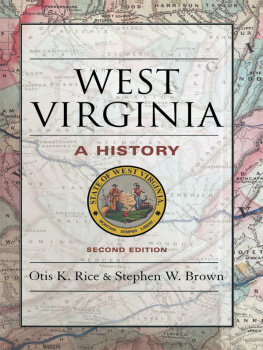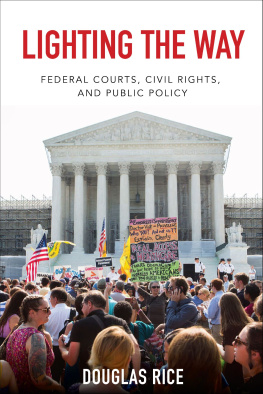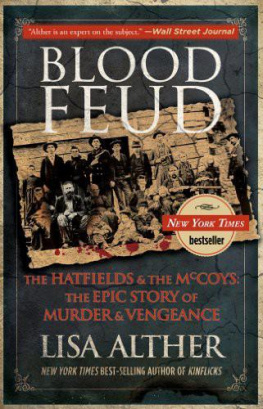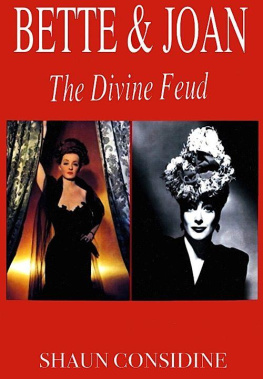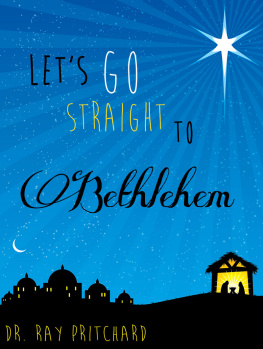THE HATFIELDS
AND THE McCOYS
The Hatfields
and
the McCoys
OTIS K. RICE
THE UNIVERSITY PRESS OF KENTUCKY
This edition was made possible in part by a grant
from the National Endowment for the Humanities.
Copyright 1982 by The University Press of Kentucky
Scholarly publisher for the Commonwealth, serving Bellarmine University, Berea College, Centre College of Kentucky, Eastern Kentucky University, The Filson Historical Society, Georgetown College, Kentucky Historical Society, Kentucky State University, Morehead State University, Murray State University, Northern Kentucky University, Transylvania University, University of Kentucky, University of Louisville, and Western Kentucky University.
All rights reserved.
Editorial and Sales Offices: The University Press of Kentucky
663 South Limestone Street, Lexington, Kentucky 40508-4008
www.kentuckypress.com
12 11 10 09 08 12 11 10 9 8
Library of Congress Cataloging-in-Publication Data
Rice, Otis K.
The Hatfields and the McCoys.
Bibliography: p.
Includes Index.
1. Hatfield-McCoy feud. I. Title.
[HV6452.K42H35 1982] 975.44804 82-1916
ISBN-10: 0-8131-1459-4 (hard cover : alk. paper) AACR2
ISBN-13: 978-0-8131-1459-0 (hard cover : alk. paper)
This book is printed on acid-free recycled paper meeting the requirements of the American National Standard for Permanence in Paper for Printed Library Materials.
Manufactured in the United States of America.
TO MY SISTERS
Alma and Rosalie Rice
AND MY GRANDNEPHEW
David Neal Thomas
Preface
W ITHOUT QUESTION, the Hatfield-McCoy feud has excited more interest than any of the late nineteenth-century vendettas of the southern Appalachian Mountains. Scores of books and articles have related its history, and novels, motion pictures, and outdoor dramas have drawn their inspiration from it. Unfortunately, too many of the depictions have been more given to sensationalism than to accuracy and objectivity.
At the outset, it must be recognized that the origins of the feud were complex and cannot be identified with one particular event. Moreover, many of the details of events in the feud may never be known with certainty, for accounts, even by participants, were often so contradictory that there is no way of determining precisely where the truth ended and fabrication began. In addition, many newspaper accounts were so biased or so grossly inaccurate that they must be used with considerable discrimination. Reminiscences in which long conversations were recalled verbatim, used by some writers, are by their very nature suspect.
The present study makes no claim to the discovery of the ultimate truth of every detail of the feud. I have tried, however, to separate myth from known facts, to present as dispassionate and balanced an account as available sources will afford, and to place the feud in the social, economic, political, and cultural context in which it occurred. I have drawn as much as possible from contemporary sources, including court records, public documents, and other materials, including newspapers, that offer a degree of reliability. Above all, I have sought to weigh evidence carefully and to avoid the partisanship and condescension that have characterized much of the writing on the feud.
In my research and writing I have incurred the usual debts that any author accumulates. As always, I have found librarians and their staffs ready to respond to my calls with the kind of assistance that only they can render. I must acknowledge special debts to Mr. William Marshall and the staff of the Special Collections of the University of Kentucky Library; Mr. Jeffrey M. Duff of the Kentucky Division of Archives and Records; Miss Linda Anderson of the Kentucky Historical Society; Mrs. Carol Warner of the West Virginia Department of Archives and History; and the staffs of the West Virginia Collection of the West Virginia University Library and the Vining Library of West Virginia Institute of Technology. Dr. Thomas D. Clark drew my attention to the collection of Pike County records in the University of Kentucky Library. My niece, Mrs. Martha Ellen Thomas, photocopied materials in the University of Kentucky Library. Leonard McCoy of Phelps, Kentucky, generously allowed me to use photographs in his possession, and Leonard W. Roberts kindly arranged with the Pike County Historical Society and the Preservation Council of Pike County, Inc., for others. My secretary, Mrs. Connie Alexander, assisted with the typing.
I especially appreciate a grant from the Research and Publications Committee of West Virginia Institute of Technology, which facilitated last-minute research. Two student assistants, Ray E. Woods, Jr., and David Hardy, assisted me in checking references and photocopying needed materials. My colleague Dr. Stephen W. Brown read the entire manuscript and, as usual, made a number of useful suggestions.
THE FEUDISTS AND THEIR SOCIETY
A STORY CARRIED by numerous newspapers in June 1977 reported great agitation among residents of the eastern Kentucky town of Pikeville over a proposal to move the graves in the Dils Cemetery to make way for a civic center and sports arena. The outcry against what ordinarily might have seemed the march of progress arose from the fact that the cemetery provided the last resting-places of Randolph McCoy, his wife Sarah, and other members of the famous Kentucky feuding family. Some of the opponents of removal of the graves must have reasoned that those whose lives had known so little peace should be left undisturbed in death. As usual, many newspaper allusions to the famous vendetta contained gross errors, among them the assertion that more than one hundred men, women, and children were killed during the feud. Only in declaring that the cause of the feud was never clear did some of them get closer to the truth.
Nearly a century has passed since the trouble between the Hatfields and the McCoys broke the quiet of the hills along the Kentucky-West Virginia border. When they finally laid aside their weapons, members of both families preferred to forget an ugly chapter in their history. In later years battle-scarred veterans of the feud seldom spoke of it. When they did reflect upon the troubles between the two families they often disagreed about their origins and details of the principal events.
Any serious study of the Hatfield-McCoy feud requires more than a mere retelling of the events which drew the conflict to national attention. Of considerable importance to an understanding of the vendetta are the characteristics and backgrounds of the two families, the nature of the environment in which they lived, the social mores of the Kentucky and West Virginia mountains, the prevailing economic patterns, the viability of political and social institutions, and even the impact of outside influences in perpetuating the feud once it started.
Let us begin with the land itself. The valley of the Tug Fork of the Big Sandy River, in which the feud occurred, is one of the most rugged and forbidding sections of the Appalachian Highlands. The Tug Fork draws its waters from scores of small tributaries that have carved deep, narrow valleys from the surrounding sandstone and limestone rocks. At Louisa, Kentucky, the Tug Fork joins the Levisa Fork to form the Big Sandy River proper, which, in turn, flows into the Ohio at Catlettsburg, Kentucky. Like much of the surrounding territory, the watershed of the Tug Fork consists of a maze of secluded valleys that long remained almost inaccessible, where men might live virtually undisturbed by outside influences. The river provided a geographical unity for the region, but, as the boundary between Kentucky and West Virginia, it divided it politically, thereby aggravating some of the conditions that nourished the Hatfield-McCoy feud.


